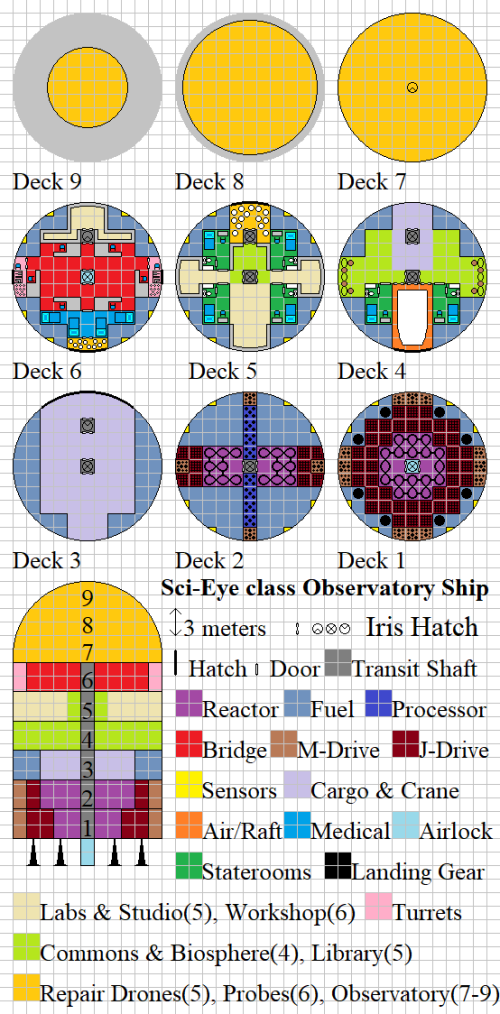Sci-Eye class Observatory Ship
| Sci-Eye class Observatory Ship | |
|---|---|
 A very mobile observatory | |
| Type: SL Observatory Ship | |
| Category | ACS |
| Size | 400 Tons |
| Hull Configuration | Cylinder Hull |
| Streamlining | Streamlined Hull |
| Tech Level | TL–11 |
| Engineering | |
| Computer | Model/2 |
| Jump | J-2 |
| Maneuver | 2 G |
| Fuel Treatment | Scoops, Purifier |
| Armaments | |
| Hardpoints | 2 |
| Accommodations | |
| Staterooms | 6 |
| Personnel | |
| Crew | 6 |
| High/Mid Passengers | |
| Payload | |
| Cargo | 40.2 Tons |
| Fuel tank | 81.8 Tons |
| Carried craft | probe/repair drones, air/raft |
| Special features | 3 labs, small observatory, workshop, library, Military grade sensors |
| Construction | |
| Origin | Terran Confederation |
| Year Operational | -2358 |
| Price | |
| Cost | MCr190.24 |
| Maintenance cost | Cr15,853 |
| Statistics | |
| Quick Ship Profile | LS-DS22 |
| Universal Ship Profile | LS-B4822S-EL |
| Images | |
| Blueprint | Yes |
| Illustration | No |
| Source | |
| Canon | Unpublished, fan design |
| Designer | Adrian Tymes |
| Design System | Mongoose 2nd |
| Era | Interstellar Wars |
| Reference | Fan: Adrian Tymes |
The Sci-Eye class Observatory Ship is a TL–11 civilian science vessel.
Description[edit]
Being an observatory dome with an extended cylindrical shaft underneath, a Sci-Eye is said to have been shaped from Terrans' dreams of what a starfaring science vessel should look like. Everywhere it goes, it can peer deep into the mysteries of the universe, with enough internal support to keep voyaging so long as the crew seeks more enigmas to explore.
The reality of Sci-Eye expeditions is somewhat different, but not entirely.
Not all science is astronomy. The observatory is more often used to obtain super-high resolution imagery from a safe distance (such as orbit) than to look at things far away. A Sci-Eye's workshop and biosphere are capable of sustaining ship and crew for decades (theoretically indefinitely if the crew can manufacture anagathics), making spare parts and food with sufficient energy and mineral inputs, which can be supplied by the fusion plant (with fuel purified aboard ship) and the laser drills (mining suitable ores) respectively - but this is a delicate balance, assuming all the equipment continues to work. In practice, especially given the variety of experiments the ship is meant to support (and the inevitable resulting minor damage to various parts of the ship), it is recommended that the crew plan to bring the Sci-Eye to a starport for resupply and minor repairs at least once a month. This also allows the crew to report on the results of its research in a timely manner, which most sponsors prefer.
A Sci-Eye has almost all the capabilities of a Sci-Can class Laboratory Ship and then some, between its larger size and its observatory dome. It does require more maintenance and carries about half the cargo, though this is a generous 10% (approximately) of its displacement, enough to carry a lot of custom equipment for any given mission.
Various minor improvements after the design was launched have dramatically increased the observatory's range of capabilities. Perhaps the most iconic image of these improvements is of one Sci-Eye hovering upside down, the tip of its observatory barely a centimeter above an earthworm analog crawling along the ground, the telescope (with its lenses and focal length dynamically adjusted from its usual role) acting as a powerful microscope to observe the worm's cells in detail as it crawled. A couple other notable uses have been tracking individual sand grains while monitoring how ocean waves shape a beach, and using thermal and x-ray imagery to get a complete picture of the insides of an active volcano in a single field of view (one 2D image at a time, but the Sci-Eye moved in a circle around the volcano to get all sides and took several images from above, from which a 3D holographic view was constructed). By temporarily moving the camera element to the top of the dome, the observatory can look a maximum of 45 degrees below horizontal, though this is rarely done unless the Sci-Eye should not be moved at that moment.
General Description & Deck Plans[edit]
- Deck Plans for this vessel.

Basic Ship Characteristics[edit]
Following the Imperial Navy and IISS Universal Ship Profile and data, additional information is presented in the format shown here. [1]
| Basic Ship Characteristics [2] | ||
|---|---|---|
| No. | Category | Remarks |
| 1. | Tonnage / Hull | Tonnage: 400 tons (standard). 5400 cubic meters. Streamlined Cylinder Hull with a dome on one end.
|
| 2. | Crew | Crew: 1 Pilot, 1 Astrogator, 1 Engineer, 1 Medic, 2 Gunners. At least half are expected to be Scientists as well. The Medic and Gunners are generally viewed as optional, and Astrogator duties are sometimes shared by one of the other crew, potentially reducing the crew to 2. Usually either the Pilot or Astrogator doubles as Captain on the official records, though the chain of command can be quite informal. |
| 3. | Performance | Acceleration: 2-G maneuver drive installed.
|
| 4. | Electronics | Model/2 ship computer. |
| 5. | Hardpoints | 2 hardpoints, with potential to add 2 more. |
| 6. | Armament | 2 turrets with a beam laser each. |
| 7. | Defenses | The same 2 turrets also each have a sandcaster. |
| 8. | Craft | One air raft. Vacc suits required for most EVA (extra-vehicle activity). Rescue Balls for crew escape normally carried. |
| 9. | Fuel Treatment | It is typically equipped with a fuel purification plant and fuel scoops. |
| 10. | Cost | MCr190.24 (no architect's fees, those having long since been paid off). MCr171.216 in quantity. |
| 11. | Construction Time | 6 months standard, 4 in quantity. |
| 12. | Remarks | An observatory mounted on a starship, the very model of a science vessel. |
History & Background (Dossier)[edit]
After the Third Interstellar War, the Terran Confederation extensively colonized both the territory it had won and the uncolonized space to rimward. During this process, it became apparent that the Ziru Sirka's policy of halting scientific research had created quite a scarcity of science-capable starships. The Terrans came up with many designs to fill this gap, of which the Sci-Eye was one of the more successful.
Despite having been designed first, the Sci-Eye eventually became known as an upgraded Sci-Can class Laboratory Ship as most surviving examples had started out as a Sci-Can. The upgrade process was well known enough that documentation on how to do it was stored anywhere that Sci-Eye and Sci-Can construction template files were stored, which records survived the Long Night in enough shipyard databases that the design was available to the Third Imperium. With about half the cargo space of a Sci-Can, and nearly double the total construction cost (and maintenance cost), Sci-Eyes are more dedicated science vessels, upgraded from a Sci-Can only when the extra cost could be justified - though in many cases the justification appears to have been sheer pride, since an observatory is an iconic piece of scientific equipment throughout Charted Space.
The upgrade - a major revamp of deck 2, minor refits to decks 3 and 5, adding the observatory, and tuning the maneuver drive and jump drive - typically costs MCr100 and takes 3 months. Downgrading is possible too, though most shipyards will charge an amount equal to the salvage this generates (mainly from removing the observatory) and pay for it by taking the salvage, making this an unattractive option to those trying to obtain quick credits. There are rumors, some verified, of shipyards that offer a discount on the upgrade in exchange for favors - usually some mission that a crew that started with a Sci-Can, paid off the mortgage, then accumulated several dozen megacredits is optimized for and can accomplish in about 2 months, taking their air raft and whatever equipment they can fit in it.
Class Naming Practice/s & Peculiarities[edit]
Ship Interior Details: See this section in the Sci-Can class Laboratory Ship article. Deck 2 has been converted to another engineering deck (the secondary transit shaft no longer extends to Deck 2). The deck 6 airlock no longer functions as an external airlock, instead becoming an entrance to the observatory, which is labeled as decks 7 through 9 for positioning's sake even though the observatory has no actual decks inside it. Power is less limited, but a Sci-Eye is no more of a warship than a Sci-Can is, and it is still the case that the jump drive and maneuver drive are not intended to be used simultaneously.
The observatory is largely open space, with light receptors and inner lenses kept in place through gravitics (reinforced by stiff wires holding things in place when necessary). The dome is selectively transparent, rather than physically opening to the outside environment, with a deformable cover that can create one or more lenses within itself as needed. The result is an extremely tunable set of telescopes (or, with the right configuration, giant microscopes), backed up by hyperspectral cameras. The ship's "ordinary" sensors, distributed around the cylindrical portion of the hull, are able to complement the observatory (such as by using lidar emitters to create laser guide stars) but are often set to background monitoring to calibrate the observatory against.
Class Naming Practice/s: As with Sci-Cans, Sci-Eyes are named for notable scientists, scientific expeditions, and/or science installations. Sci-Eye names tend to favor grander and/or more astronomically focused references; many Sci-Eyes built during the Third Imperium have been named for IISS heroes who explored unknown or forgotten stars.
Selected Variant Types & Classes[edit]
11 Representative Laboratory Ship (SL) Classes[edit]
References[edit]
| This article has metadata. |
This ship was designed using Mongoose 2nd ship design rules.
|
- Author: Adrian Tymes
- ↑ Timothy B. Brown. Fighting Ships (Game Designers Workshop, 1981), 10.
- ↑ Timothy B. Brown. Fighting Ships (Game Designers Workshop, 1981), 10.